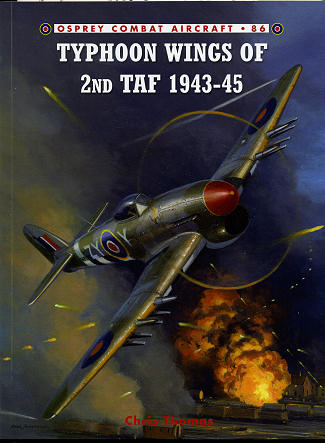 Often
times there are important aircraft built in rather large numbers that goes
somewhat unnoticed by the aviation enthusiast. One of these is Hawker's Typhoon.
Initially developed as a replacement for the Hurricane, it was rushed into unit
service where its many faults were quickly revealed. Though quite fast at low
level, its Sabre engine lost a lot of power above 15,000 feet, pretty well
dooming it as a dogfighter. European air to air combat usually took place at or
above these levels. Its Sabre engine was also a cause of a lot of trouble. It
was prone to catching fire, gave off a prodigious amount of CO2, requiring its
pilots to be on oxygen as long as the engine was running, and initially
had a very short engine life of about 25 hours.
Often
times there are important aircraft built in rather large numbers that goes
somewhat unnoticed by the aviation enthusiast. One of these is Hawker's Typhoon.
Initially developed as a replacement for the Hurricane, it was rushed into unit
service where its many faults were quickly revealed. Though quite fast at low
level, its Sabre engine lost a lot of power above 15,000 feet, pretty well
dooming it as a dogfighter. European air to air combat usually took place at or
above these levels. Its Sabre engine was also a cause of a lot of trouble. It
was prone to catching fire, gave off a prodigious amount of CO2, requiring its
pilots to be on oxygen as long as the engine was running, and initially
had a very short engine life of about 25 hours.
Naturally, this was not good, but the plane had a great deal
of promise thanks to its heavy armament of four 20mm cannon and it was decided
to use it mostly for ground attack. It was fitted with bomb racks and later
rocket rails for the then secret rocket projectiles (RP). The aircraft was
developed rather quickly as faults were found and fixed. Unit service showed
that the framed canopy was not good and a 'bubble' canopy was developed and
retrofitted. The original three blade prop was replaced by a four blade version
and the engine woes were eventually brought under control. It was also found
that the tail section was weak and several failed under load. The fault was
thought to be elevator flutter and while the elevators were fixed and the tail
reinforced, it didn't totally eliminate rear fuselage failures.
Regardless, the war meant that the aircraft had to be in unit
service in enough numbers to operate with the newly formed 2nd TAF (Tactical Air
Force) that would be accompanying Allied ground forces in their march through
Europe after D-Day.
This book by Chris Thomas follows the design and development
of the Typhoon. It's initial squadron introductions and modifications is also
clearly detailed. But the brunt of the book is on the use of the Typhoon with
the 2nd TAF. All of the various wings and squadrons are provided sections and as
the war progresses, we can follow their exploits until the end of the war. It
has a goodly number of pilot and crew stories, with some of the more interesting
characters in these units highlighted. Not surprisingly, with the end of the
war, a huge number of these war weary airframes were soon reduced to scrap with
only the best still left continuing on in the RAF.
Typical of Osprey books, there are a superlative number of
period photos of the planes and those who flew them. This is further enhanced by
a large selection of color profiles by author that show examples of the Typhoon
as the war progressed.
This is an outstanding book on the subject and is one that I
can easily recommend to you.
October 2010
For more on the complete line of Osprey books,
visit www.ospreypublishing.com. In the US, it is
Osprey Direct at 44-02 23rd St, Suite 219, Long Island City, NY 11101., where you can
get a catalogue of available books.
If you would like your product reviewed fairly and quickly, please contact
me or see other details in the Note to
Contributors.
 Often
times there are important aircraft built in rather large numbers that goes
somewhat unnoticed by the aviation enthusiast. One of these is Hawker's Typhoon.
Initially developed as a replacement for the Hurricane, it was rushed into unit
service where its many faults were quickly revealed. Though quite fast at low
level, its Sabre engine lost a lot of power above 15,000 feet, pretty well
dooming it as a dogfighter. European air to air combat usually took place at or
above these levels. Its Sabre engine was also a cause of a lot of trouble. It
was prone to catching fire, gave off a prodigious amount of CO2, requiring its
pilots to be on oxygen as long as the engine was running, and initially
had a very short engine life of about 25 hours.
Often
times there are important aircraft built in rather large numbers that goes
somewhat unnoticed by the aviation enthusiast. One of these is Hawker's Typhoon.
Initially developed as a replacement for the Hurricane, it was rushed into unit
service where its many faults were quickly revealed. Though quite fast at low
level, its Sabre engine lost a lot of power above 15,000 feet, pretty well
dooming it as a dogfighter. European air to air combat usually took place at or
above these levels. Its Sabre engine was also a cause of a lot of trouble. It
was prone to catching fire, gave off a prodigious amount of CO2, requiring its
pilots to be on oxygen as long as the engine was running, and initially
had a very short engine life of about 25 hours.